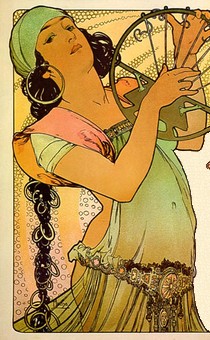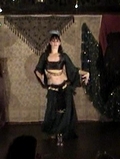
|
|
|
|
|
|
|
|
|
|
| Contact us |

Shakti's Sacred Dance WorkshopsShakti is ecstatic to be back on Kaua'i and is offering 2 classes on ancient sacred dance in celebration of her return:
|
 |
Balancing Things On Your HeadBalancing things on your head begins with the feet. Many westerners walk on their heels since our shoes (sneakers, in particular) restrict flexion throughout our feet. I have seen my 3 children (who were usually barefoot) begin life walking from ball to heel. Once they start wearing hard-soled shoes, they soon shift into walking from their heel to the ball of their foot to compensate for the lack of flexion in their feet caused by the hard sole. The interesting thing is that when you walk on the heel of your foot, there are very few muscular structures above the heel able to absorb the shock of the impact of your foot hitting the ground. Thus we are told to buy special shoes with cushiony, bouncy heels in athletics in order to absorb the impact of running, jumping, and otherwise exercising so we don't jar our joints. On the other hand, if the first thing that hits the ground is the ball of the foot, there are scads of little muscles throughout the foot and ankle specifically designed to cushion, absorb, and rotate around impact. To feel this firsthand, try bouncing up and down (lightly) on the balls of your feet. Now try it on your heels. See what I mean? So how does this relate to balancing things on your head? Well, when you walk (or dance) if the first thing that hits the ground is the ball of your foot, then all the little muscles that are designed to cushion & rotate around the impact can come into play and prevent the k'banging! in your body that would knock whatever's on your head right off. Let's talk about the big toe for a minute. Your big toe is an incredibly sensitive organ. It is not designed to take weight, but rather is the "eye" of your foot. It is the part of your foot that detects what is on the ground that you don't want to step on lest it hurt your foot. If you tune into your big toe's capability to "see" what's on the ground, you will not need to look down in order to avoid rocks and other prickly objects; Your toe will find them for you. By listening to the toe, then placing the ball down gently and the heel behind it, your foot will have time to react to any unsuspected prickles on the ground and seamlessly flex, rotate, and bridge over / around them. Listen to your feet when balancing things on your head! They will give you all of the information that you need about the terrain on which you are dancing. The next thing to pay attention to is your head. Obviously, when you are balancing something on your head, you can't tip it from side to side, jerk it back and forth, or bounce it up and down (unless you're very advanced) without the thing that you're balancing sliding off! So your head should stay pretty stationary. What about your body between your head and feet? How should that move? Well, any way that absorbs the bounce between your feet moving and your head staying still is correct. That is where the dancing comes in and belly dancing, with its isolated and sinuous movements, is absolutely perfect for this. Before you can dance with something on top of your head, it is a good idea to become skilled at walking with something on top of your head. What should I balance on my head?Different objects have different levels of difficulty. In terms of typical bellydance objects, swords are easiest, followed by canes (if they've been rubber banded), then trays and bowls, and finally candelabras. Here are the basic principles involved:
What are the advantages of balancing things on my head?Okay, this is not just a flashy party trick. Here are just some of the many benefits of mastering the art of walking (& dancing) smoothly enough to carry something on your head:
Have fun! |
||
Other Mideastern & Sacred Dance Class Topics
|
||
For more information, please contact us at: shakti.dance@gmail.com
(808) 635-0688